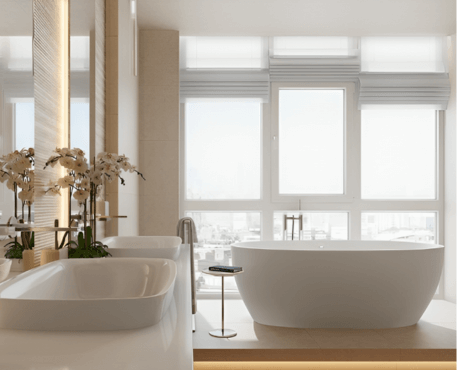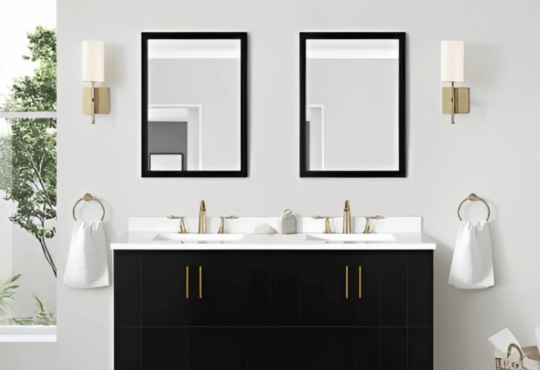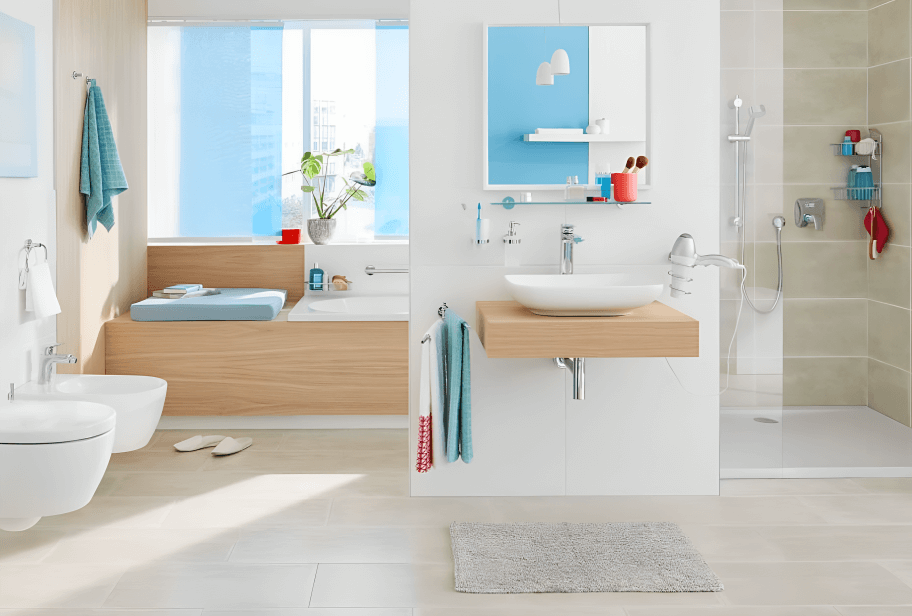
Ensuring Safety and Comfort in the Bathroom
Designing a Bath Safety ;The bathroom is an essential part of any home, and ensuring its safety is of paramount importance. Bath safety is not only crucial for the elderly or those with mobility issues but for everyone who uses the bathroom. The risk of accidents in the bathroom, such as slips, falls, or other injuries, can be mitigated through proper design and adherence to important safety rules. In this article, we will explore the vital rules for designing a bath safety, focusing on creating a space that is both safe and comfortable.
Designing a safe and comfortable bathroom is crucial for the well-being of everyone in the household. By following these bath safety rules, you can create a secure, functional, and pleasant bathroom, whether for aging in place, accommodating mobility issues, or enhancing home safety, ultimately improving the occupants’ quality of life and peace of mind.
1.Non-Slip Flooring
One of the most critical aspects of bath safety is the flooring. Bathroom floors are often wet, which increases the risk of slipping and falling. To mitigate this risk, use non-slip flooring materials. Options include textured tiles, anti-slip mats, and even non-slip coatings. These materials provide better traction and reduce the likelihood of accidents.
2.Grab Bars
Install grab bars strategically throughout the bathroom. These bars offer support and stability when entering or exiting the shower or bathtub, or when moving around the bathroom. They should be securely mounted to the wall, capable of bearing the user’s weight, and placed at appropriate heights.
3.Shower Benches and Seats
Shower benches or seats can significantly enhance bath safety, especially for individuals with mobility issues. They provide a convenient place to sit while showering, reducing the risk of slipping or falling in the shower. Ensure that the bench or seat is water-resistant and properly installed.
4.Adequate Lighting
Proper lighting is essential for bathroom safety. Inadequate lighting can make it difficult to see obstacles and hazards. Install bright, evenly distributed lighting to eliminate shadows and dark corners. Consider motion-activated lighting for added convenience and energy efficiency.
5.Low Curb or Curbless Shower Entry
For those with mobility challenges, a curbless shower entry is ideal. It eliminates the need to step over a high threshold, reducing the risk of tripping. Alternatively, a low curb or ramped entry is a safer option, as it minimizes the height difference between the bathroom floor and the shower.
6.Temperature Control
Scalding accidents are common in bathrooms due to hot water. Install anti-scald devices, such as thermostatic mixing valves, to regulate water temperature and prevent sudden bursts of scalding hot water. These devices help maintain a safe and comfortable water temperature.
7.Adequate Space
Ensure there is sufficient space in the bathroom to move comfortably, especially if the bathroom is used by individuals with mobility aids or wheelchairs. Aim for a spacious layout that allows easy maneuverability without obstacles or tight corners.
8.Slip-Resistant Bathmats
Bathmats placed inside and outside the shower or bathtub can help prevent slips. Look for bathmats with non-slip backing and ensure they are regularly cleaned to maintain their effectiveness.
9.Handheld Showerheads
Handheld showerheads are an excellent addition to a safe bathroom design. They allow users to direct the water where they need it, making bathing easier for individuals with limited mobility. Ensure that the showerhead can be easily adjusted and securely held.
10.Safe Storage Solutions
Proper storage is key to bathroom safety. Avoid clutter and ensure that all toiletries, cleaning products, and accessories are well-organized and within reach. Consider open shelving, storage baskets, and wall-mounted storage options to keep the space tidy and safe.
Continuing from the previous article, let’s delve deeper into each of these important rules for designing a bath safety:
11.Slip-Resistant Textures
Apart from non-slip flooring, you can incorporate slip-resistant textures in other areas of the bathroom as well. For instance, consider using slip-resistant textures on the bathtub or shower floor to provide extra traction. This is especially important for those with balance or mobility issues.
12.Adjustable Showerheads and Faucets
Accessible design is key to ensuring a bathroom is suitable for individuals with varying needs. Install adjustable showerheads and faucets to accommodate people of different heights and abilities. This customization allows for a more comfortable and convenient experience for all users.
13.Raised Toilet Seats
Toilet safety is a significant concern, especially for older adults and those with mobility issues. Raised toilet seats can make it easier to sit down and stand up, reducing the strain on the knees and making the bathroom experience more comfortable.
14.Door Width and Swing
Consider the width of the bathroom door and its swing direction. A wider door with a swing that accommodates accessibility needs is important for wheelchair users or those with mobility aids. A pocket door or sliding door can be a practical solution in limited spaces.
15.Color Contrast
Effective use of color contrast can help people with visual impairments navigate the bathroom more easily. Consider contrasting colors for walls, fixtures, and accessories. This makes it easier for people to differentiate between different elements in the bathroom.
16.GFCI Outlets
Ground Fault Circuit Interrupter (GFCI) outlets are essential in the bathroom, as they help protect against electrical shock. Make sure that all electrical outlets in the bathroom are GFCI-rated to enhance safety when using electrical devices near water sources.
17.Anti-Scald Valve
In addition to anti-scald devices, an anti-scald valve can be installed in the shower or bathtub. This valve helps maintain water temperature at a consistent level and can be set to a safe maximum temperature to prevent scalding.
18.Slip-Resistant Tub Coatings
If you have a bathtub, applying a slip-resistant coating to the bottom of the tub can provide an extra layer of protection against slips and falls. This coating creates a textured surface that improves traction.
19.Accessible Storage
For individuals with mobility challenges, make sure that storage solutions, such as cabinets and shelves, are easily reachable. Lowering storage options and incorporating pull-out or pull-down shelves can ensure that toiletries and other items are accessible without excessive bending or stretching.
20.Wheelchair Accessibility
If you are designing a bathroom for someone who uses a wheelchair, be mindful of the clear floor space required for maneuvering. Aim for a minimum of 60 inches in diameter for a full 360-degree turn, and ensure there are grab bars strategically placed for transferring to and from the wheelchair.
21.Regular Maintenance
Bath safety doesn’t end with the initial design. Regular maintenance is crucial to ensure that all safety features continue to function effectively. This includes checking grab bars, non-slip materials, and any safety devices to make sure they are secure and in good working order.
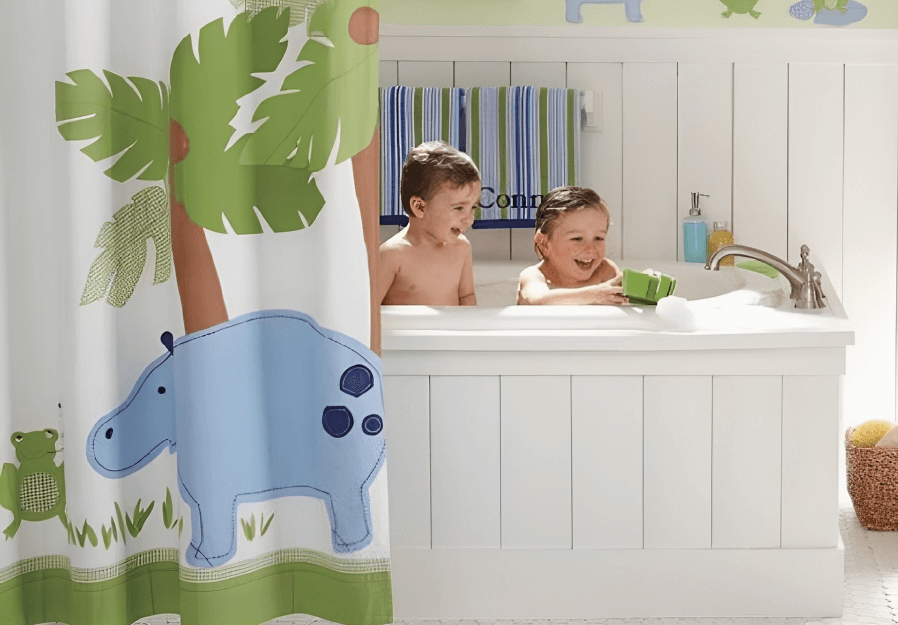
Important rules to designing a baby bath
We mentioned previously that a child has the right to use the entire home, and we must take into account the presence of children while designing any space in the home. Today we talked about a children’s bath or a shared bathroom How do we make it a friend of the child during use?
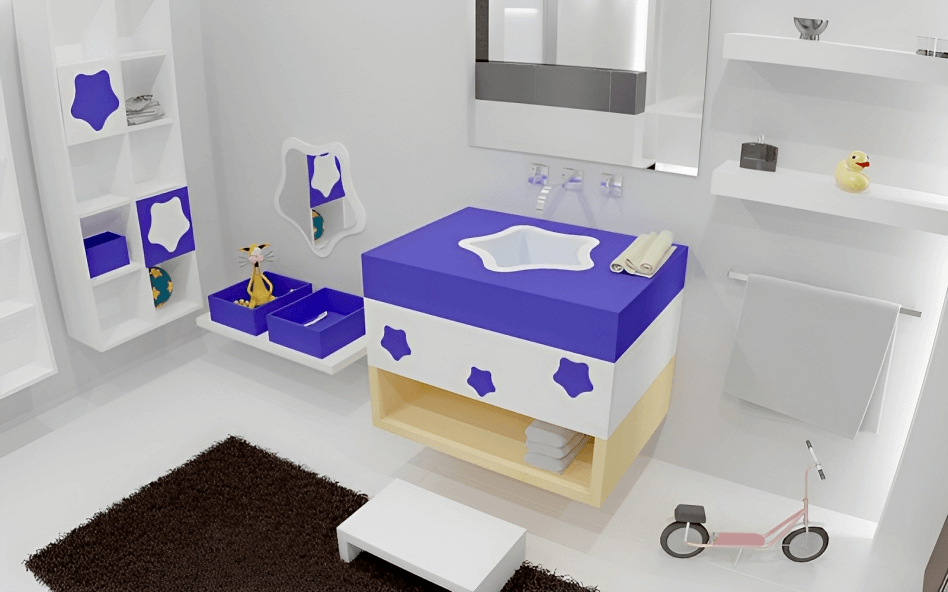
Child friendly bath design standards
Storage
There is no easier chaos in the lives of children, so we must help them to arrange by providing the basic for arrangement and they must apply, so providing basic places for every purpose inside the bathroom helps to arrange the vacuum by knowing its location and easy access to it.
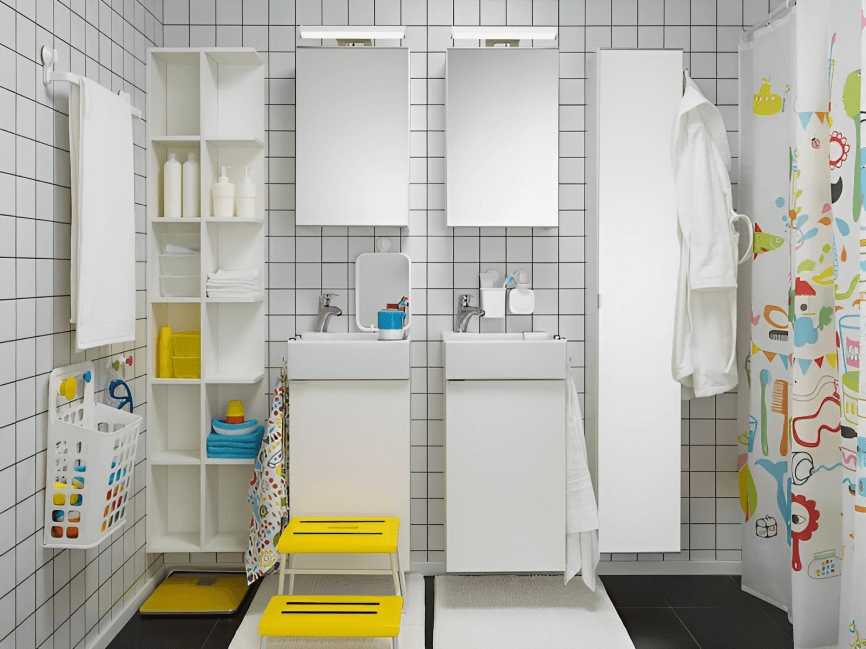
Towels
Towels should be within their reach, either under a hand wash basin or in a side storage basket at a height that suits them. Another shower item, for example, is why we do not put it in a designated corner for easy use and return when finished using it.
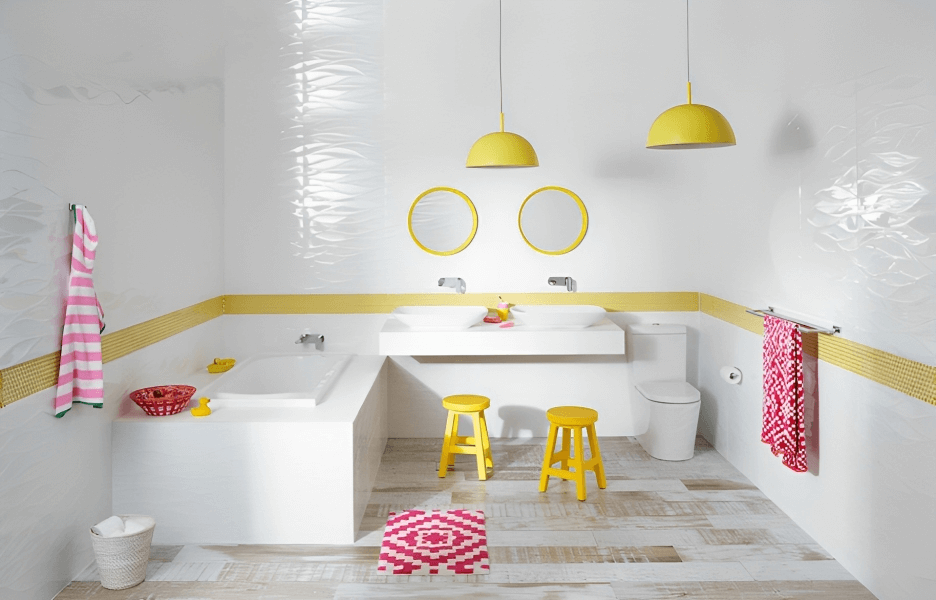
Sink design
If the bathroom is shared with both of you or your children of all ages, then taking into account the height of the sink will be an imperative to facilitate the smooth use of it by everyone. You may use a wheelchair or a staircase under the sink for the child to climb.
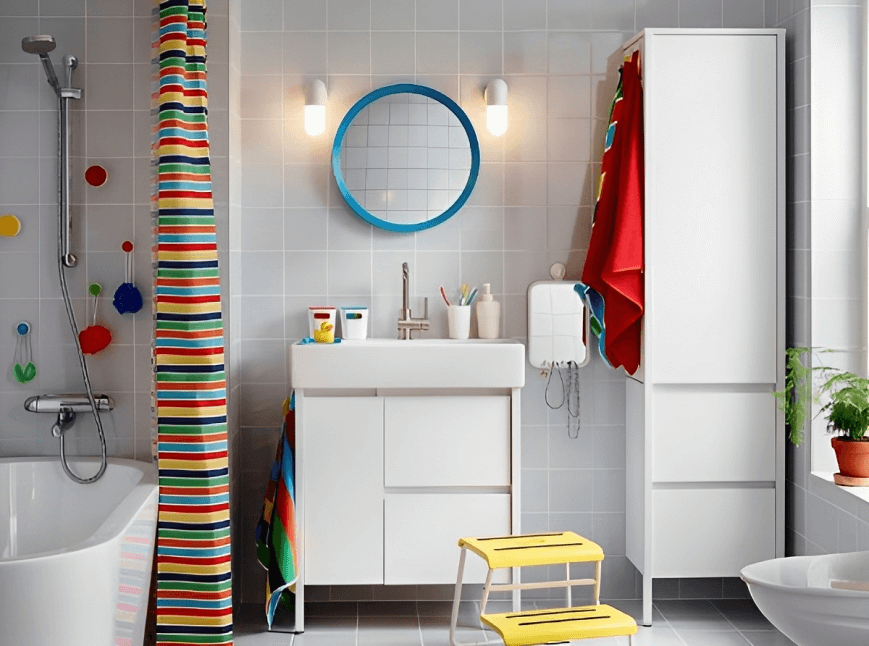
And if you do not have enough space, you may want to resort to other solutions, such as using a sink that has drawers below and make a solid drawer for use, for example.
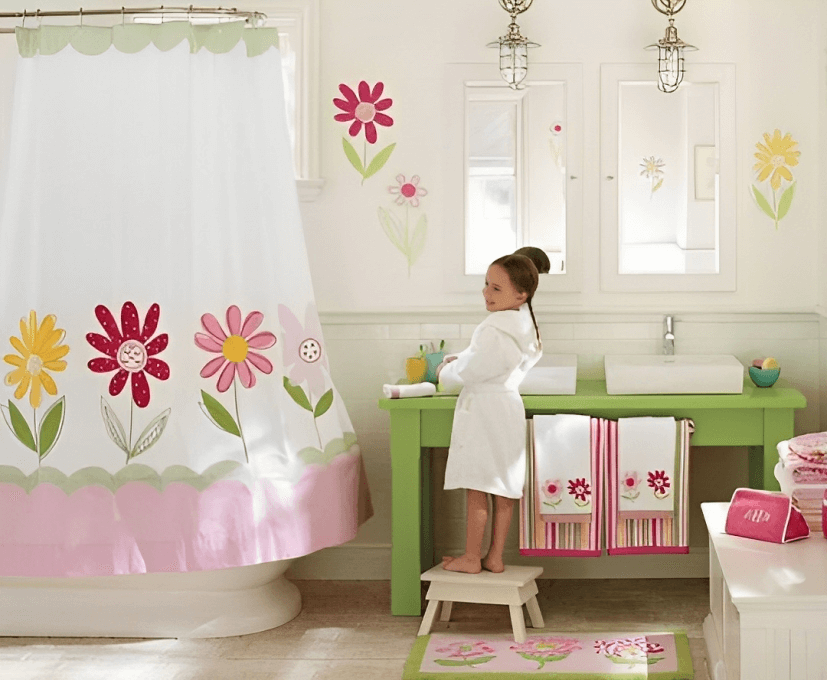
If you suffer from a delay in the morning while the children are preparing to leave the house, why not provide two washbasins inside the children’s bath or a two-tap washbasin, so you can reduce the time needed to prepare.
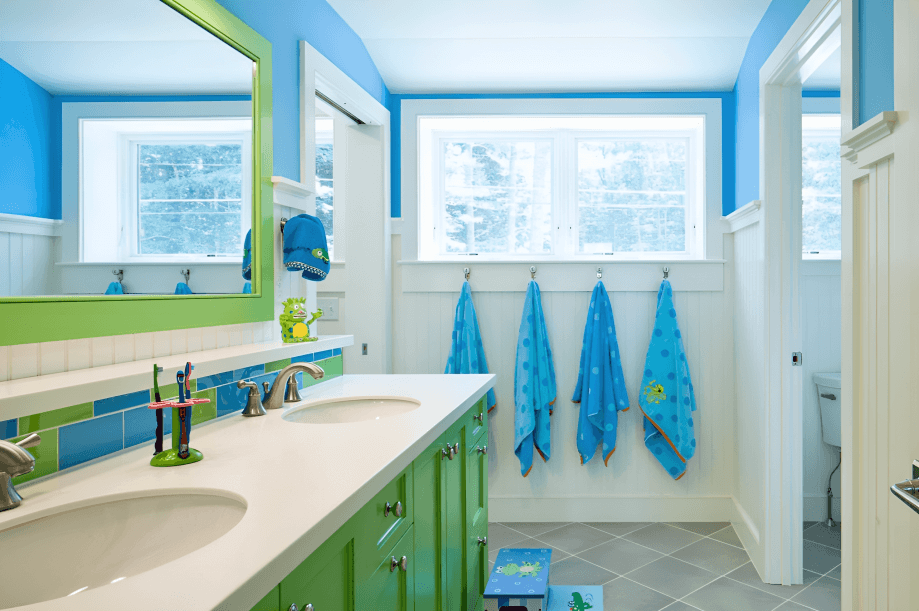
Suspension units
If the bathroom is shared, more towel hangers are a must! Thus, every child will have a place to hang their towels and there is no reason to leave towels on the bathroom floor.
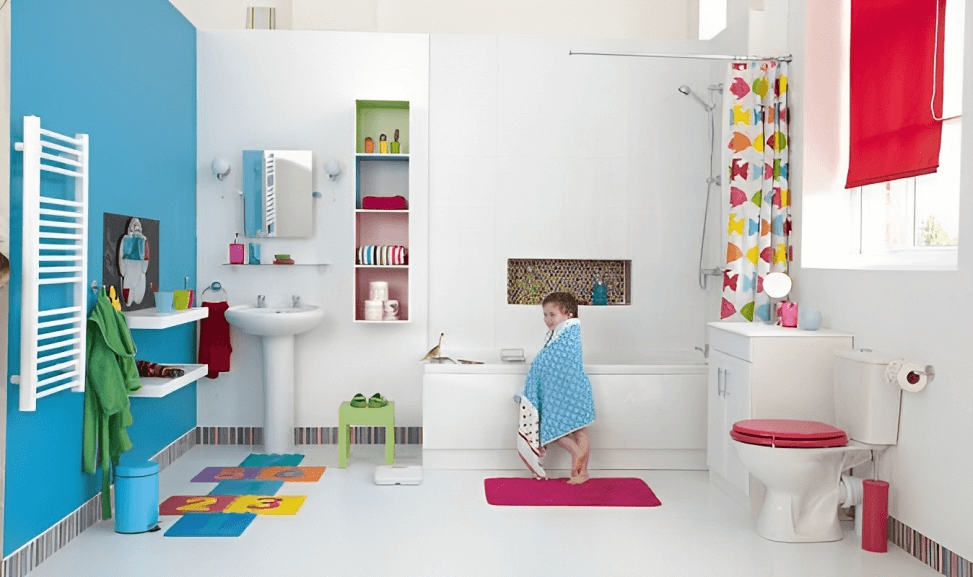
Recently, spaces inside the wall appeared for storage at the bathtub, usually at eye height for an adult.
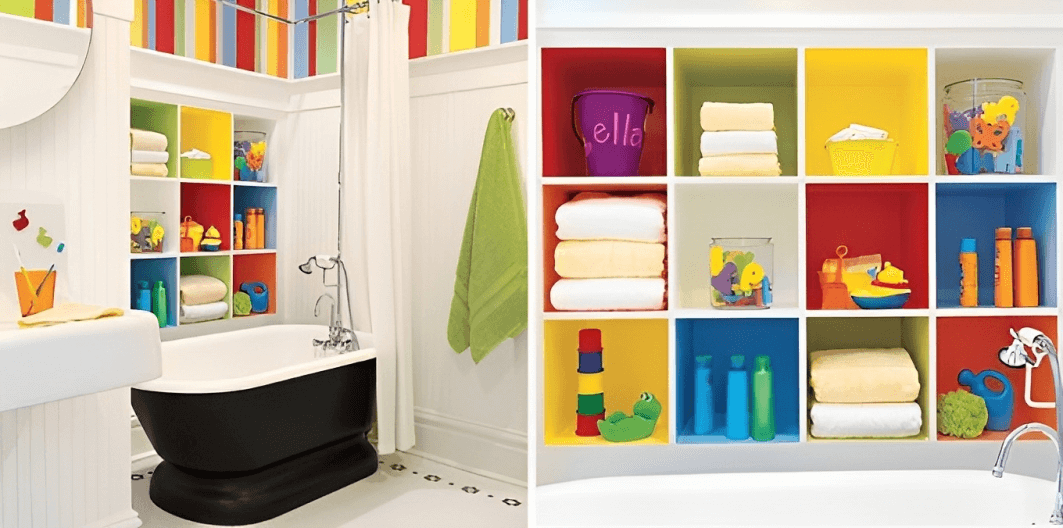
If you are in the process of designing a bathroom, there is no harm in adding some of these spaces at the height of the children’s eye to store the shower gel or on the side to put some shower toys, for example.
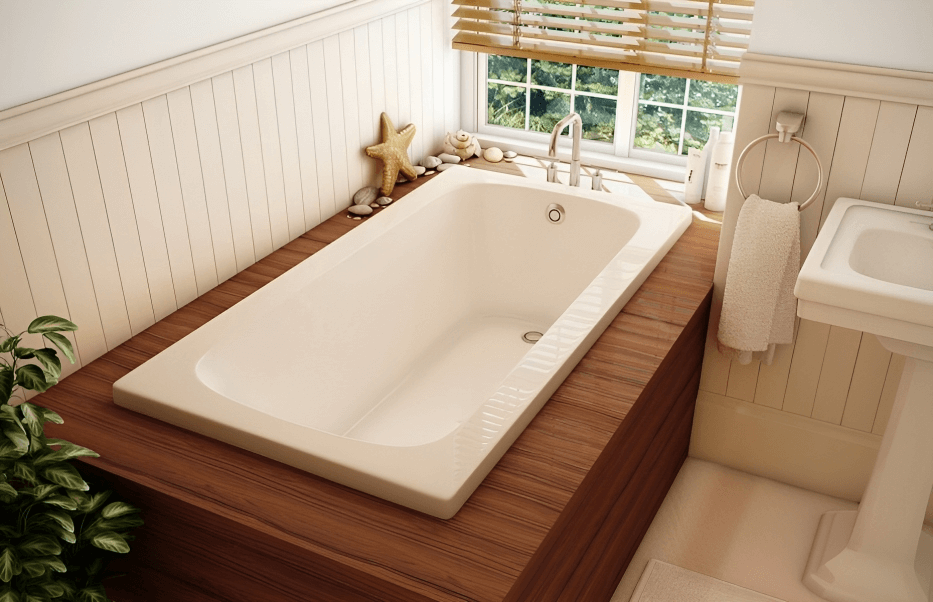
If the bathing vacuum for both of you is a “shower”, adding a part for sitting built with the shower is a favorable matter that makes it easy for you to bathe the child while he is small and provides space for playing during the shower, and it is also useful even for adults!
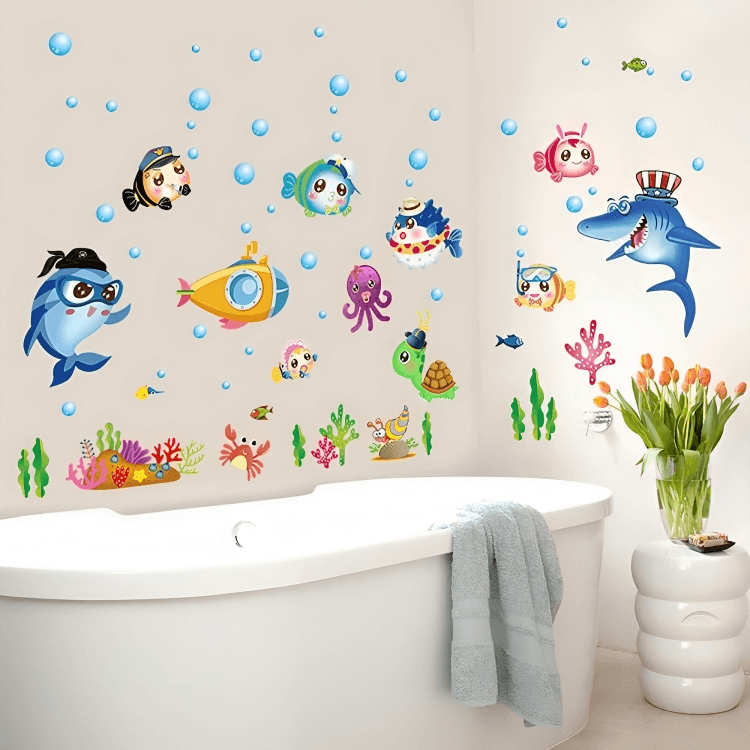
Colors and design of walls
The bathroom design does not need to be full of bright colors. You may just have to put the bathroom wallpaper on one of the walls or on a corner of the place.
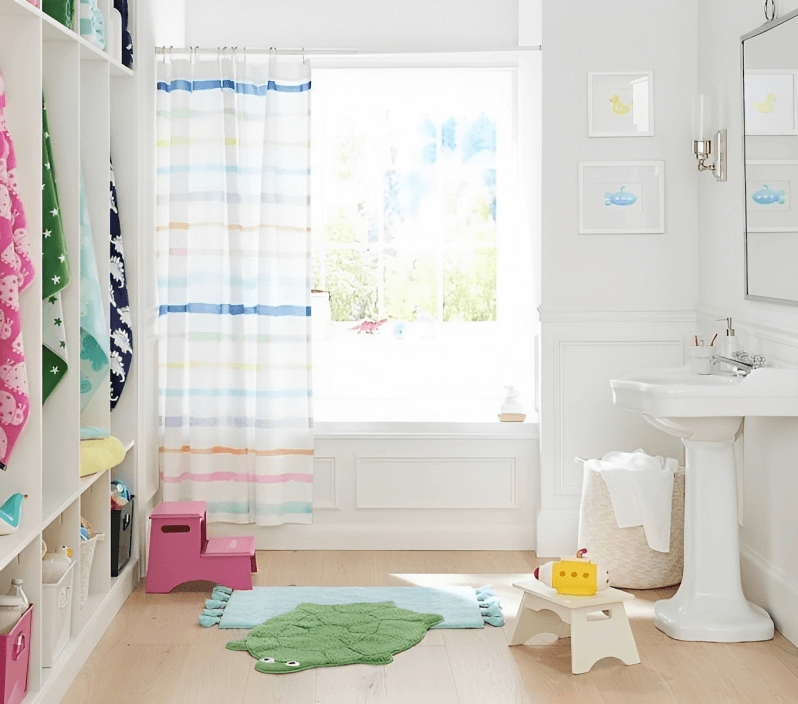
Your choice of colors can be through tools or furniture in the bathroom, a colored water tap for the bathtub, a distinctive color sink, or bathroom-related accessories such as a curtain of a distinct color for example.
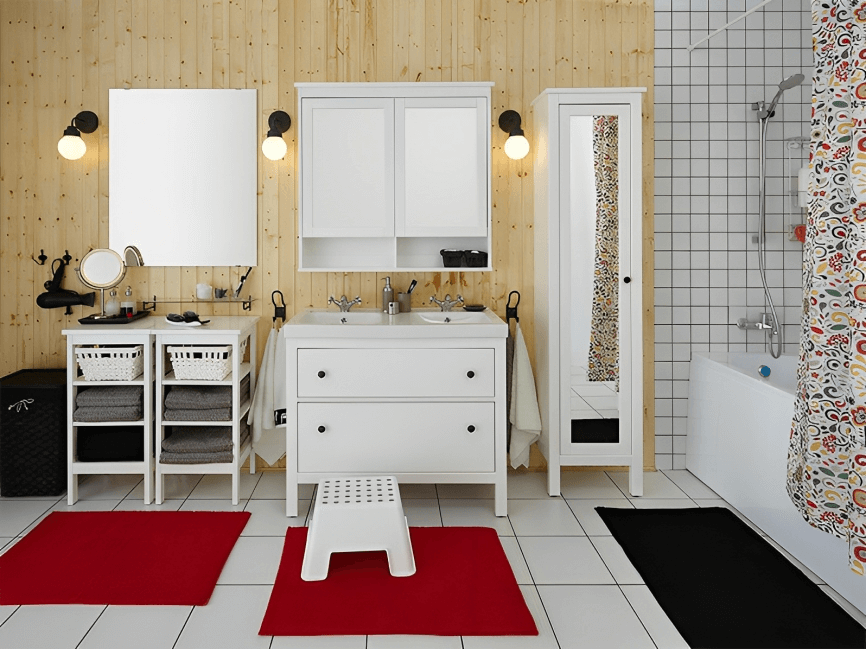
If you want to design the bathroom so that it continues with the child during his development, neutral colors are the best, a white bathroom is always the best. When we are young, we put some colorful accessories for a childish and teenage character, we return to neutral colors with accessories that reflect the teenager’s personality.
Conclusion
Designing a bathroom with safety in mind is essential for people of all ages and abilities. These rules guide you in creating a safer and more comfortable bathroom. Remember, bathroom safety requires ongoing maintenance to ensure continued effectiveness, allowing you to design a beautiful space that prioritizes user well-being.
Certainly! Here are some frequently asked questions related to designing a bath safety and their answers:
1. Why is bath safety so important?
- Bath safety is essential to prevent accidents, especially in a wet and often slippery environment like the bathroom. Falls and injuries in the bathroom can be serious, so designing for safety is crucial for people of all ages and abilities.
2. What are some non-slip flooring options for the bathroom?
- Non-slip flooring options include textured tiles, anti-slip mats, and non-slip coatings. These materials provide better traction on wet bathroom floors and reduce the risk of slipping.
3. How do I determine the right placement for grab bars?
- Grab bars should be strategically placed near the shower or bathtub entry, by the toilet, and anywhere else that may require support. Ensure they are securely mounted and capable of bearing the user’s weight. Consult with a professional for proper placement.
4. Is a curbless shower entry suitable for all bathrooms?
- While a curbless shower entry is ideal for improving accessibility and safety, it may not be feasible in all bathrooms due to structural limitations. In such cases, consider a low curb or a ramped entry.
5. What is the purpose of an anti-scald device in the bathroom?
- An anti-scald device, such as a thermostatic mixing valve, helps regulate water temperature, preventing sudden bursts of scalding hot water. This ensures a consistent and safe water temperature during showers or baths.
6. How can I make a bathroom more accessible for wheelchair users?
- To make a bathroom wheelchair accessible, ensure wider doors with an accessible swing, create a clear floor space for maneuvering, lower storage solutions, and install grab bars for transferring to and from the wheelchair.
7. What is the difference between GFCI outlets and regular outlets in the bathroom?
- GFCI (Ground Fault Circuit Interrupter) outlets are specifically designed for areas near water sources. They automatically shut off the power if they detect a fault, reducing the risk of electrical shock in wet environments.
8. How often should I check and maintain bath safety features?
- Regular maintenance is essential. Check and maintain safety features like grab bars, non-slip materials, and safety devices on a yearly basis or as needed to ensure they are secure and in good working condition.
9. Are there any grants or funding options available for making a bathroom more accessible?
- Some government programs and nonprofit organizations offer grants or funding for home modifications to enhance accessibility. Check with your local authorities or organizations dedicated to assisting individuals with disabilities for more information.
10. Can bath safety features be aesthetically pleasing in design?
- Yes, bath safety features can be both functional and visually appealing. Many safety products are designed to blend seamlessly with the bathroom’s decor, ensuring that safety doesn’t compromise the aesthetics of the space.
Remember that designing for bath safety not only enhances the safety of the bathroom but also contributes to the overall quality of life and peace of mind for the occupants. If you have specific questions about designing for bath safety in your unique situation, it’s advisable to consult with a professional or an occupational therapist who specializes in home accessibility.



